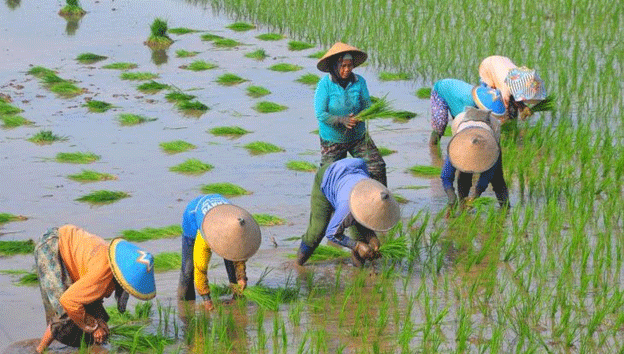Indonesia is set to experience a significant boost in rice production in 2024, with projections indicating a 10% increase compared to previous years. This positive outlook is largely driven by forecasts of a La Niña weather pattern, which typically brings increased rainfall to the region. According to Minister of Agriculture Amran Sulaiman, the surplus in rice production is expected to peak between August and October 2024, with an anticipated record high of 2.87 million tons of rice in September—making it the largest surplus in the past decade.
La Niña is known for causing wetter-than-average conditions across Indonesia, which can be highly beneficial for rice farming, as paddy fields thrive with ample water supply. However, while increased rainfall can promote better yields, it also requires careful management to prevent issues such as flooding or waterlogging, which could damage crops. Agronomists and agricultural engineers are thus focused on ensuring that the benefits of La Niña are fully realized without adverse effects on crop quality.
This year’s strong production forecast follows a decade of mixed results for Indonesian rice farmers. While rice remains the staple food for over 270 million Indonesians, the country has struggled with fluctuating yields due to irregular weather patterns, pest outbreaks, and challenges in agricultural infrastructure. The predicted surplus in 2024 could mark a turning point, potentially reducing reliance on rice imports and stabilizing domestic rice prices.
Recent data from the Ministry of Agriculture shows that in 2023, Indonesia produced approximately 55 million tons of rice. With the projected 10% increase, the total rice production for 2024 could surpass 60 million tons. This would significantly exceed domestic consumption needs, which typically hover around 30 million tons annually, and would allow for increased stockpiling and potential export opportunities.
For Indonesian farmers, this surplus presents both opportunities and challenges. On the one hand, higher yields mean more rice to sell, which can increase incomes, especially if the government continues to provide support through favorable pricing mechanisms and subsidies. On the other hand, a surplus can lead to lower market prices if demand doesn’t keep pace with supply, which may negatively impact profits for farmers. Additionally, managing post-harvest losses and ensuring efficient storage and distribution will be crucial to making the most of this surplus.
From an agronomic perspective, the challenge lies in optimizing the benefits of La Niña while mitigating its potential risks. Water management, pest control, and timely planting and harvesting will be key areas of focus. Agricultural engineers are also working on improving infrastructure, such as irrigation systems and flood prevention measures, to ensure that the increased rainfall translates into higher yields without causing damage to crops.
Looking forward, the projected surplus highlights the need for strategic planning in the agricultural sector. Indonesia’s ability to handle this surplus effectively could open up new avenues for rice exports and strengthen its position in the global rice market. However, this will require a coordinated effort from farmers, policymakers, and industry stakeholders to ensure that the surplus translates into long-term benefits for the country’s food security and agricultural economy.
Indonesia’s projected rice surplus for 2024 is a promising development, driven by favorable weather conditions and strategic planning. While the surplus presents opportunities for boosting farmer incomes and enhancing food security, careful management of resources and market dynamics will be essential to fully capitalize on this increase in production. The agricultural sector must continue to innovate and adapt to ensure that the benefits of La Niña extend beyond a single harvest season.
Error




